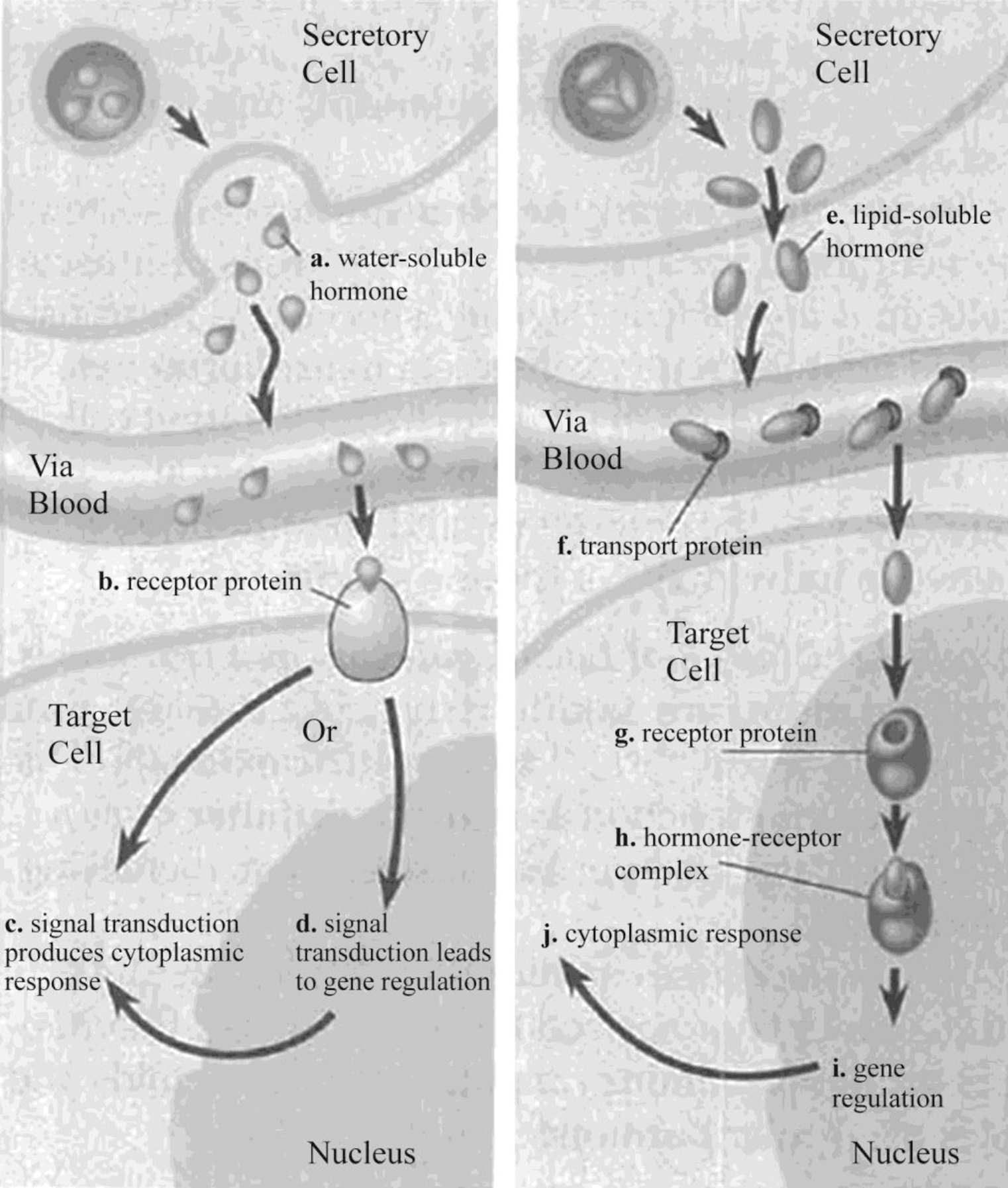
Label the parts of the following diagrams, indicating which parts represent a water-soluble hormone and which a lipid-soluble hormone.

To label: The parts of the given diagram by indicating the parts that represent a water-soluble hormone and a lipid-soluble hormone.
Introduction: Hormones are small molecules that act as chemical messengers in the body. They regulate the body processes by binding to their specific receptors. For lipid-soluble hormones, the receptors are intracellular and for water-soluble hormones, the receptors are present on cell surface.
Answer to Problem 1IQ
Pictorial representation: Fig.1 represents the pathway of a water-soluble hormone and a lipid-soluble hormone.

Fig. 1: Pathway of a water-soluble hormone and a lipid-soluble hormone
Explanation of Solution
Water-soluble hormones bind to cell surface receptors of their target cells, which stimulate gene expression and cause cytoplasmic changes. They cannot travel inside the cells through the plasma membrane because of its insoluble nature in the lipid. Transfer of the extracellular chemical signal to intracellular response is termed as signal transduction. Peptide hormones act through signal transduction pathways. Once water-soluble hormones bind to their receptors, they activate transfer of cytoplasmic protein to the nucleus, leading to alteration in gene expression.
Lipid-soluble hormones cross the barrier of the plasma membrane and interact with receptors, which are present in the cytoplasm or nucleus. It results in the formation of the hormone–receptor complex. The hormone receptors that bind to lipid-soluble hormone in their circulation are called as lipid-soluble hormone receptors. They are usually present in the cytoplasm or nucleus. The hormone–receptor complex is formed to initiate transcription by interaction with deoxyribonucleic acid (DNA).
Want to see more full solutions like this?
Chapter 45 Solutions
Study Guide for Campbell Biology
- Which hormones produced in the posterior and anterior lobes of the pituitary gland have the targets indicated? Below, fill in the blanks using the abbreviations noted in Section 15.3.arrow_forwardA physician sees a patient whose symptoms include sluggishness, depression, and intolerance to cold. After eliminating other possible causes, the doctor diagnoses a hormone problem. What disorder fits the symptoms? Why does the doctor suspect that the underlying cause is a malfunction of the anterior pituitary gland?arrow_forwardEach steroidogenic organ has all the enzymes necessary to produce any steroid hormone. (True or false?)arrow_forward
- Visit this link (http://openstaxcollege.org/l/adrenalglands) to view an animation describing the location and function of the adrenal glands. Which hormone produced by the adrenal glands is responsible for mobilization of energy stores?arrow_forwardFigure 37.14 Hyperthyroidism is a condition in which the thyroid gland is overactive. Hypothyroidism is a condition in which the thyroid gland is underactive. Which of the conditions are the following two patients most likely to have? Patient A has symptoms including weight gain, cold sensitivity, low heart rate, and fatigue. Patient B has symptoms including weight loss, profuse sweating, increased heart rate, and difficulty sleeping.arrow_forwardWhich of the following stimulate the secretion of hormones? a. neural signals b. local chemical changes c. hormonal signals stimulate hormone secretion d. environmental cues e. all of the above canarrow_forward
 Human Physiology: From Cells to Systems (MindTap ...BiologyISBN:9781285866932Author:Lauralee SherwoodPublisher:Cengage Learning
Human Physiology: From Cells to Systems (MindTap ...BiologyISBN:9781285866932Author:Lauralee SherwoodPublisher:Cengage Learning Human Biology (MindTap Course List)BiologyISBN:9781305112100Author:Cecie Starr, Beverly McMillanPublisher:Cengage Learning
Human Biology (MindTap Course List)BiologyISBN:9781305112100Author:Cecie Starr, Beverly McMillanPublisher:Cengage Learning Anatomy & PhysiologyBiologyISBN:9781938168130Author:Kelly A. Young, James A. Wise, Peter DeSaix, Dean H. Kruse, Brandon Poe, Eddie Johnson, Jody E. Johnson, Oksana Korol, J. Gordon Betts, Mark WomblePublisher:OpenStax College
Anatomy & PhysiologyBiologyISBN:9781938168130Author:Kelly A. Young, James A. Wise, Peter DeSaix, Dean H. Kruse, Brandon Poe, Eddie Johnson, Jody E. Johnson, Oksana Korol, J. Gordon Betts, Mark WomblePublisher:OpenStax College Biology (MindTap Course List)BiologyISBN:9781337392938Author:Eldra Solomon, Charles Martin, Diana W. Martin, Linda R. BergPublisher:Cengage Learning
Biology (MindTap Course List)BiologyISBN:9781337392938Author:Eldra Solomon, Charles Martin, Diana W. Martin, Linda R. BergPublisher:Cengage Learning Biology: The Dynamic Science (MindTap Course List)BiologyISBN:9781305389892Author:Peter J. Russell, Paul E. Hertz, Beverly McMillanPublisher:Cengage Learning
Biology: The Dynamic Science (MindTap Course List)BiologyISBN:9781305389892Author:Peter J. Russell, Paul E. Hertz, Beverly McMillanPublisher:Cengage Learning





